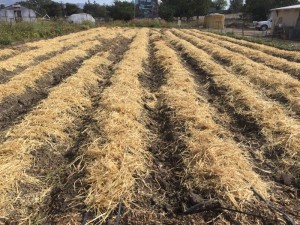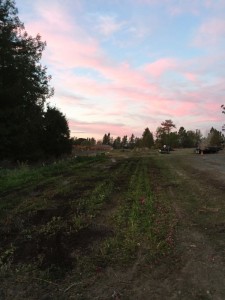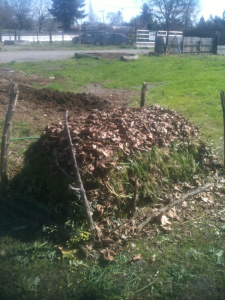Here we are in that familiar time of year where it’s suddenly frigid at night, the wind is whipping the leaves off trees, and the days are shockingly short – every day. As we move from the golden days of fall into the dormant winter, it’s hard to know what to do to best take care of the garden. Luckily, now is a prime time to get in the garden and make sure you are prepared for the coming season. Here are my top four tips for preparing your garden for winter to ensure healthy, productive soil next spring.
Protect Cold-Hardy Crops Against Freezes
If you’re like me, you’ve got all different types of plants still in the ground right now that can theoretically handle severe cold weather. But like a nervous mother, I worry! As a general rule of thumb, the more established a plant is, the better it will fare with extreme temperatures. Plants with established, extensive root systems will better hold up against cold weather.
So, how do you prepare your garden for winter and protect your established plants? Well, there are many ways to protect them, but I make sure to always focus on the youngest, and therefore most vulnerable, plants first. A first layer of dense is a heavy mulch of wood chips or straw around the base.

Then comes row cover – thin white fabric that allows light and moisture to penetrate while still providing some protection. You can either drape it over plants and trees or use hoops or tomato cages to support the fabric a bit more. Bed sheets, as our grandmothers all knew, can also do the trick (just remember to remove them once in a while to let some air and light in). I’ve used all these methods to protect everything from kale to citrus trees to perennial flowers. My last piece of advice to help protect established plants during winter is remember to water them! If we’re between rains, check your soil to make sure it hasn’t dried out completely, and give your plants a good dose if it has.
It’s Not Too Late To Cover Crop!
We’ve talked about cover crop before on the blog, and I’m sure we’ll talk about it again – it’s just that important. Cover crop is, of course, a crop that you grow with the express purpose of feeding your soil – fixing nitrogen, providing organic matter, holding off erosion – in short, giving back to the land. While there are all different kinds of cover crop depending on your location, goals, time of year, and soil type, I would argue growing a cover crop now is the best way to prepare your garden for winter. You can also grow cover crops during the summer, but your garden space is at a premium and you may not want to favor long-term soil care for short-term juicy vegetables. It’s all a balance. Enter winter cover crops – when you’re probably not doing much else with your garden anyway.
I choose a mixture of bell beans, oats, vetch, and peas – the idea being that the legumes will fix nitrogen in your soil, and the grasses will help cycle nutrients and then break down into good organic matter. I aim to sow directly in the ground by about October 15th (I’ve only got it done on schedule once, so don’t worry if you’re much later than this). It’s early December, and I can report that at Petaluma Bounty, cover crop is in the ground and already growing beautifully. At B-Side Flower Farm, however, I have yet to sow any! The last of the fall flower crops have been mowed to the ground and I just have to get in there and till up the ground a bit before sowing my cover crops.

If you’ve already sown your cover crop and it doesn’t seem to be growing or doing much of anything, it’s not too late to encourage growth and/or to re-sow. First of all, look into the moisture level of your soil. If you sowed your seeds and they sat there in soil that was too dry or soil that has since dried out, you need to water your soil down to about half an inch. Cover crop is pretty easy going and should grow fairly well throughout the winter with no supplemental water (especially with the forecast this winter), but they may need a little head start with irrigation.
Prep Soil Now For Spring Beds
In terms of getting your soil ready for an early spring planting, we’re in a little bit of luck in that the rains have held off. Once the soil becomes saturated with water and sits there wet all winter, you may have to wait until late spring for the ground to dry out enough to work with. I’ve said it before but it bears repeating – don’t try to rush and get into the ground or garden beds before the soil has properly dried out! If you do, you’re at risk of major compaction and squeezing out valuable air space in between your soil particles.
What I recommend instead is prepping some beds now and then shielding them from winter rains so that you can get in there with early plantings in the spring. Many early spring crops like peas, greens, larkspur, ranunculus, and sweet peas will thank you for it. What I recommend is to choose the beds or space that you want to reserve for your early spring crops, add a two-inch thick layer of compost, and mix it into the top foot of soil with a fork or shovel. Then cover the bed space with cardboard and a thick layer of straw, wood chips, leaves, or a combination of all. This will allow you to rake these ingredients off of the soil in early spring while the rest of the ground is still drying out. If you prepare your garden for winter now, you will be rewarded with healthy, workable soil in the early spring!
It’s a Great Time To Make Compost
Making compost is one of the best ways to prepare your garden for winter, because let’s face it, we’re all too busy in the garden during summer to make as much compost as we need for our crops. I try to make as much as possible in the ‘off’ season while I have more time and fewer chores to do in the fields.

There are many ways to make compost (many of you out there surely are old pros at it). I’ve talked before about some of my favorite methods. My tried and true compost piles are composed of manure, old crop residue, food scraps, and straw. The manure can be either from cows or horses. In our area it’s really very easy to get your hands on either one. I am careful to talk to the ranchers I source from and to make sure there no harmful ingredients making their way into the manure like pesticides or herbicides (and then I always wear gloves!).
I make a lasagna-like square pile, alternating equal layers of all my materials until I run out. After covering it with a tarp, the pile can sit there for a few months to decompose. It’s a good idea to go in and ‘turn it’, or mix it up really well with a shovel, a few times throughout the winter. This will introduce air back into the pile and allow the microorganisms to keep busy breaking down the materials and turning them into lofty, nutrient-rich compost to be added to your garden during the spring. Again, preparing your garden for winter now will make things so much easier come early spring!
So let’s get outside, take advantage of the delayed rains (they ARE coming!) and prep our gardens to rejuvenate over the winter. Coming up on the blog we’ll be focusing on the best things to think about when planning for next season.







 Family
Family

